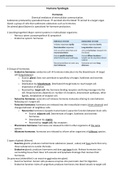College aantekeningen
Aantekeningen hoorcolleges Humane Fysiologie
- Instelling
- Universiteit Van Amsterdam (UvA)
In dit document van 20 pagina's staan aantekeningen van hoorcolleges en 1 werkcollege van Humane Fysiologie beschreven, inclusief afbeeldingen. De aantekeningen zijn gedeeltelijk in het Nederlands en gedeeltelijk in het Engels geschreven.
[Meer zien]




